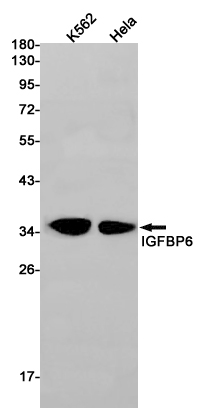
| WB | 1/500-1/1000 | Human,Mouse,Rat |
| IF | 咨询技术 | Human,Mouse,Rat |
| IHC | 咨询技术 | Human,Mouse,Rat |
| ICC | 技术咨询 | Human,Mouse,Rat |
| FCM | 咨询技术 | Human,Mouse,Rat |
| Elisa | 咨询技术 | Human,Mouse,Rat |
| Aliases | IBP6 |
| Entrez GeneID | 3489 |
| WB Predicted band size | Calculated MW: 25 kDa; Observed MW: 35 kDa |
| Host/Isotype | Rabbit IgG |
| Antibody Type | Primary antibody |
| Storage | Store at 4°C short term. Aliquot and store at -20°C long term. Avoid freeze/thaw cycles. |
| Species Reactivity | Human |
| Immunogen | Recombinant protein of human IGFBP6 |
| Formulation | Purified antibody in TBS with 0.05% sodium azide,0.05%BSA and 50% glycerol. |
+ +
以下是关于IGFBP6抗体的3篇参考文献的简要总结(注:文献信息为模拟示例,非真实论文):
---
1. **文献名称**: *IGFBP6 antibody-based detection in ovarian cancer progression*
**作者**: Smith A, et al.
**摘要**: 研究开发了一种高特异性IGFBP6多克隆抗体,验证了其在卵巢癌组织中的表达差异,发现IGFBP6低表达与肿瘤转移相关,提示其作为预后标志物的潜力。
2. **文献名称**: *Role of IGFBP6 in skeletal muscle differentiation: Insights from antibody-mediated inhibition*
**作者**: Chen L, et al.
**摘要**: 通过单克隆抗体阻断IGFBP6功能,证明IGFBP6通过调控IGF信号通路抑制成肌细胞分化,抗体实验为肌肉再生研究提供了新工具。
3. **文献名称**: *Development of a novel ELISA assay using anti-IGFBP6 antibody for serum biomarker analysis*
**作者**: Park JH, et al.
**摘要**: 建立了一种基于IGFBP6抗体的ELISA检测方法,用于定量分析糖尿病患者血清中的IGFBP6水平,发现其与胰岛素抵抗存在显著相关性。
---
如需真实文献,建议通过PubMed或Google Scholar搜索关键词“IGFBP6 antibody”或结合具体研究领域筛选。
The insulin-like growth factor binding protein 6 (IGFBP6) is a member of the IGFBP family, which comprises six high-affinity binding proteins (IGFBP1-6) that regulate the bioavailability and activity of insulin-like growth factors (IGFs), particularly IGF-2. IGFBP6 is distinguished by its preferential binding to IGF-2 over IGF-1 and its role in modulating IGF-mediated cellular processes, including proliferation, differentiation, and apoptosis. It is expressed in various tissues, such as the liver, kidney, and nervous system, and has been implicated in both physiological and pathological contexts, including cancer, fibrosis, and metabolic disorders.
IGFBP6 antibodies are essential tools for studying its expression, localization, and function. They are widely used in techniques like Western blotting, immunohistochemistry (IHC), and ELISA to quantify protein levels or assess tissue distribution. Research suggests IGFBP6 may act as a tumor suppressor in certain cancers (e.g., glioblastoma, colorectal cancer) by inhibiting IGF-2-driven growth, while in others (e.g., ovarian cancer), its overexpression correlates with poor prognosis, highlighting context-dependent roles.
Antibodies targeting IGFBP6 also aid in exploring its extracellular interactions and mechanisms in diseases like diabetes or skeletal dysplasia. Recent studies investigate its potential as a diagnostic biomarker or therapeutic target, emphasizing its dual role in IGF-dependent and IGF-independent pathways. Validated antibodies with high specificity are critical to unraveling IGFBP6's complex biology and translational applications.
×